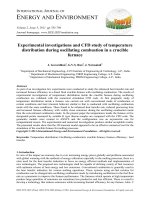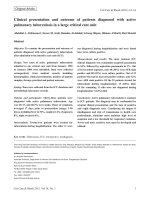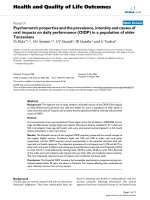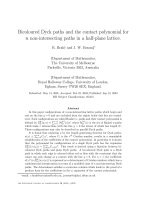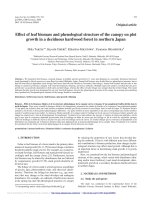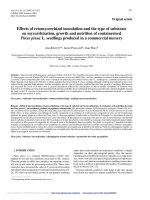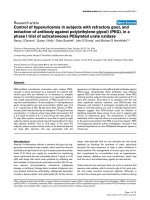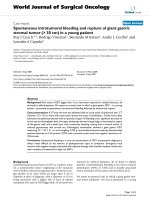Hematology and plasma chemistry valuesfor production tilapia (oreochromis hybrid) raised in a recirculation system
Bạn đang xem bản rút gọn của tài liệu. Xem và tải ngay bản đầy đủ của tài liệu tại đây (851.67 KB, 10 trang )
Hematology and Plasma Chemistry Values
for Production Tilapia (Oreochromis hybrid)
Raised in a Recirculation System
T.C. Hrubec and S.A. Smith
Aquatic Medicine Laboratory
Virginia-Maryland Regional College of Veterinary Medicine
Department of Biomedical Sciences and Pathobiology
Duck Pond Drive, Blacksburg, VA 24061
ABSTRACT
Tilapia are a frequently aquacultured fish, yet little is known about
their normal physiology and response to disease. To assess specific
diseases in mammals, blood constituents are routinely analyzed and
compared to previously determined standardized values. Research to
establish hematologic values for normal healthy fish is required before
blood analysis can be used for diagnostic purposes in fishes. This study
determined hematology and plasma chemistry values for production
tilapia (Oreochromis hybrids) raised in a recirculation system. Using
standard clinical techniques, the following hematologic parameters were
determined: PCV (packed cell volume), plasma protein and MCV (mean
cell volume) values; and erythrocyte, leukocyte, lymphocyte (small and
large), neutrophil, monocyte, eosinophil, thrombocyte-like-cell, and
thrombocyte numbers. Additionally, the following plasma chemistry
values were determined: total protein, albumin, globulin, creatinine, total
bilirubin, ALP (alkaline phosphatase), AST (aspartate aminotransferase),
sodium, potassium, chloride, calcium, phosphorus, magnesium, glucose,
cholesterol, ammonia and osmolality. Analysis of blood parameters can
enhance production of hybrid tilapia by providing a means for the early
detection of infectious diseases, and by assisting in the identification of
sub-clinical conditions affecting production performance.
International Journal of Recirculating Aquaculture, vol. l, no. 1
5
INTRODUCTION
Tilapia are the second most commonly cultured fish in the world, and are
a food staple in many parts of Africa, Asia, and South America (CEAH
1995; Anonymous 1996). In the USA, tilapia consumption has increased
and these fish are the fourth most commonly cultured fish. Intensive
aquaculture of tilapia, as with other species of finfish, is adversely affected
by production-related disorders and infectious diseases (CEAH 1995). Th.is
is particularly true of fish raised in recirculating systems, where high
stocking densities promote the spread of infectious diseases. As the
aquaculture industry expands, there is an increasing need for improved
diagnostic methods to detect disease and to diagnose causes of poor
production performance. Hematology and clinical chemistry analysis are
not regularly used in fishes, as baseline values are not available for most
species; however, blood analysis can provide significant diagnostic
information once baseline values are established. Successful culture and
maintenance of tilapia can be enhanced by developing such a clinical tool
to monitor the health of production fish. Previously reported blood values
for tilapia are from non-production or low intensity production tilapia
(Terao and Ogawa 1984; Haniffa and Vijayarani 1989; Hussein et al. 1996).
This present study determined a complete profile of hematologic and
biochemical blood values for production hybrid tilapia raised in a
commercial recirculating system. Th.is profile can serve as a guide for
comparisons in the analyses of blood values from other production hybrid
tilapia.
MATERIALS AND METHODS
Hybrid tilapia were stocked into a 231,900 L recirculation system as
fingerlings. At the time of sampling, the fish had an average weight of
551 g, a length of 26.7 cm and were stocked at a density of 70 g/L. The
fish were fed a commercial tilapia feed (Tilapia Grower - floating,
Southern States Cooperative, Richmond, VA, USA) at 2% of body
weight per day. Water quality was monitored at the times of sampling for
standard parameters and the values are shown in Table 1. Fish with any
gross abnormalities were not included in the study.
The fish were rapidly netted, anesthetized in aerated buffered tricaine
methanesulfonate (MS-222, Sigma Chemical Co. St. Louis, MO, USA)
6
International Journal ofRecirculatingAquaculture, vol. l, no. 1
Table 1. Mean water quality values for hybrid tilapia maintained in high
density (70 g/L) recirculating systems.
PARAMETER
VALUE
Temperature (0 C)
29
pH
7.2
NH3 un-ionized (mg/L)
0.017
N0 2-N (mg/L)
0.39
N0 3-N (mg/L)
54
Alkalinity (mg/L)
188
Hardness (mg/L)
154
DO (mg/L)
8.0
and bled with a 23 gauge needle and a 3 mL syringe from the caudal
vessels. The collected blood was placed in blood tubes containing either
ethylenediamine tetra-acetic acid (EDTA) for hematological analysis, or
lithium heparin for chemistry analysis. Any hemolyzed or clotted
samples were discarded before analysis.
Blood from the EDTA tube was drawn into microhematocrit tubes (Fisher
Scientific, Norcross, GA, USA) and the packed cell volume (PCV)
determined after centrifugation at 10,000 x g for 5 min. Plasma protein was
determined with a clinical refractometer using plasma from the
microhematocrit tube. The total red cell count and total white cell counts
were determined manually as previously described (Hrubec et al. 1996a)
with a Neubauer hemacytometer using Natt-Herrick's solution (Natt and
Herrick 1952) as a diluent stain. Briefly, as thrombocytes can not be reliably
distinguished from leukocytes on the hemacytometer, both were counted to
give a combined leukocyte/thrombocyte count. Thrombocytes were then
enumerated and subtracted from the combined count during the differential.
Manual determination of total red and white cell counts is recommended for
use with fish blood, as the nucleated red cells prevent accurate enumeration
using automated analysis (Huffman et al. 1997). Blood smears, using the
EDTA treated blood, were stained with Wright's Geimsa stain and used for
the differential count as described previously (Hrubec et al. 1996a).
Blood in the heparinized tubes was centrifuged (14,000 x g) for 5 min
and the plasma collected and frozen at -10°C until analyzed
· International Journal of Recirculating Aquaculture, vol. l, no. 1
7
(approximately 3 weeks later). Plasma samples were analyzed using an
automated dry chemistry system (Kodak Ektachem 700, Rochester, NY,
USA) for total protein, albumin, creatinine, total bilirubin, alkaline
phosphatase (ALP), aspartate aminotransferase (AST), sodium, chloride,
potassium, calcium, magnesium, phosphorus, glucose, cholesterol, and
ammonia. Dry chemistry analysis systems are standardized and
automated to reduce variation in results. They are used routinely in
human and veterinary medicine, and have been documented to be
accurate for fish samples (Warner et al. 1978; Warner et al. 1979; Smith
and Ramos 1980). Globulin was calculated from the difference between
the total protein and albumin. Osmolality was determined using an
osmometer (Multiosmette Micro-Osmometer 2430, Precision Systems
Inc., Natick, MA, USA).
Table 2. Hematologic values for production tilapia reared in recirculating
systems.
Analyte
n1
Range
Mean
SEM2
PCV3 (%)
35
23-35
28
0.5
Plasma Protein (mg/di)
35
4.9-8.4
6.3
0.2
Erythrocytes (x 106/µL)
35
1.96-2.91
2.43
0.046
MCV4 (fl)
35
90-143
114
2
Leukocytes (#/µL)
31
13,200-110,300
55,700
4111
Small
31
9,300-78,900
44,200
3170
Large
31
700-11,700
4,000
469
Neutrophils (#/µL)
30
1000-9,300
3,200
348
Monocytes (#/µL)
30
0-3,300
900
148
Eosinophils (#/µL)
31
0-1,600
500
83
TLC5 (#/µL)
31
500-5,700
1,800
235
Thrombocytes (#/µL)
31
18,800-80,300
39,500
2787
Lymphocytes (#/µL)
Number offish,
Standard error of the mean,
3 Packed cell volume,
4 Mean cell volume,
5 Thrombocyte-like-cell
1
2
8
International Journal of Recirculating Aquaculture, vol. l, no. 1
RESULTS and DISCUSSION
Although tilapia are one of the most frequently cultured fish in the
world, there are surprisingly few papers that present normal blood values
(Terao and Ogawa 1984; Haniffa and Vijayarani 1989; Hussein et al. 1996).
In these previous studies, only a few fish were used, or only a small
number of analytes were determined. Additionally, these studies were
conducted on pure species of non-production tilapia and not the more
commonly cultured hybrids. The blood values of the pure strains may be
quite different from the values for a production hybrid. The data presented
in the present study should be relevant for production hybrids raised in
recirculating systems under similar culture conditions.
The values for the hematologic parameters are given in Table 2. The
plasma protein, white cell count and differential white cell count can
provide valuable information about the immune and inflammatory
responses of an individual. The packed cell volume, red cell count and
MCV can provide information about anemias and red cell production and
hydration status. The hematologic values determined in this study are
comparable to those published previously with the exception of Haniffa
and Vijayarani ( 1989) who reported lower PCV ( 10% ), and erythrocyte
counts (0.9 xl06/µL) in Oreochromis mossambicus. Conversely, Terao
and Ogawa (1984) reported higher PCV values (35%) in Tilapia nilotica.
The leukocyte types observed in the fish from the present study: small
lymphocytes, large lymphocytes, neutrophils, monocytes, and
eosinophils, are similar to those described for Oreochromis mossambicus
(Doggett et al. 1987) and other species of fish (Ellis 1977). The
thrombocyte-like-cell (TLC) is a cell type that has been identified in
different species, and superficially resembles a thrombocyte and
probably represents a maturational stage of one of the leukocytes
(Hrubec et al. 1996a).
The values for the plasma chemistry parameters are given in Table 3.
Total protein, albumin and globulin can provide information about the
immune status, liver function, hydration and osmoregulation. The blood
chemistries: AST, ALP, total bilirubin, creatinine, and cholesterol can
indicate changes in organ function; while the electrolytes and plasma
osmolality are indicators of osmoregulatory ability. Electrolytes and
glucose can also provide information about stress levels. Comparison of
previously reported blood values with those determined in this study
International Journal of Recirculating Aquaculture, vol. l, no. 1
9
Table 3. Serum biochemical values for production tilapia reared in
recirculating systems.
Parameters
nt
Range
Mean
SEM2
Total Protein (g/dL)
40
3.9-8.6
5.8
0.3
Albumin (g/dL)
40
1.8-3.0
2.4
0.1
Globulin (g/dL)
40
2.1-5.6
3.4
0.2
Creatinine (mg/dL)
40
0.2-0.6
0.4
0.02
Total bilirubin (mg/dL)
40
0.1-0.5
0.2
0.02
ALP3 (U/L)
37
12-48
28
1
AST4 (U/L)
28
21-770
238
44
Sodium (mEq/L)
40
141-161
151
1
Potassium (mEq/L)
40
3.57-6.16
4.84
0.1
Chloride (mEq~)
39
110-129
121
1
Calcium (mg/dL)
40
16.5-165.0
60.1
6.58
Phosphorus (mg/dL)
38
9.8-60.1
21.5
1.7
Magnesium (mg/dL)
38
2.8-5.0
3.7
0.1
Glucose (mg/dL)
39
49-120
78
3
Cholesterol (mg/dL)
40
126-313
208
8
Ammonia (µmol/L)
39
157-500
324
17
Osmolality (mOsm)
39
310-359
328
2
Number offish,
2 Standard error ofthe mean,
J Alkaline phosphatase
4 Aspartate aminotransferase (SGOT)
1
revealed similar values for most analytes. Terao and Ogawa (1984) did
report higher levels of creatinine (4.3 mg/d.L), chloride (192 mEq/d.L),
cholesterol (567 mg/d.L), and glucose (408 mg/d.L) and lower levels of
calcium (11.8 mg/d.L) in Tilapia nilotica. Hussein et al. (1996) reported
slightly lower levels of total protein, albumin and globulin (3.4, 0.7, and
2.7 g/d.L respectively). The blood values reported in this present study
are generally consistent with those of other species of finfish (McDonald
and Milligan 1992). The calcium and phosphorus levels are higher than
usually reported for other species, but the reason for this is unknown.
10 International Journal ofRecirculatingAquaculture, vol. l, no. 1
Differences in hematologic and biochemical blood values may be due
to a wide variety of factors. Blood values in fishes are affected by
capture and sample collection technique, environmental factors, culture
conditions, diet, and age and sex of the fish (McDonald and Milligan
1992; Lane 1979; Ram-Bhaskar and Srinivasa-Rao 1989; Hrubec et al.
1996a,b; Hrubec et al. 1997a,b). Additionally, as reported previously,
different hybrids of striped bass have different normal blood values
(Hrubec et al. 1996a). In the current study, the tilapia were hybrids of the
parental species used in the previously published tilapia hematology
studies. The water quality in the production tanks, although typical for
intensively reared hybrid tilapia in recirculating systems, is different
from the water quality of non-production tanks. These differences may
account for some of the variance observed between studies.
In order to develop hematology and clinical chemistry as diagnostic
tools for use with fishes, one must determine normal values and then
determine whether environmental factors influence these values. Finally,
one determines how the values change under pathologic conditions. In
the early stages of this process, the range of normal blood values may
appear unduly broad until the effects of external factors that influence the
blood values (water quality, diet, age, culture conditions, etc.) are
identified and mitigated. This is the most likely cause for the range of
values observed in this study. Similar ranges of normal values were
observed in hybrid striped bass from high density recirculating systems
(Hrubec et al. 1996a,b).
Taken together, the analyses of hematologic and biochemical
parameters provide direct information on the overall immune status and
health of an individual, contributing information relevant to disease
diagnosis. As the aquaculture industry expands, tools to monitor the
health status of fishes using standardized non-lethal and inexpensive
methods will be needed. This study provides baseline blood values for
production hybrid tilapia in a recirculation system. Generating these
values is the first step in developing hematology as a diagnostic tool for
use in these fish.
International Journal of Recirculating Aquaculture, vol. l, no. 1
11
ACKNOWLEDGEMENTS
The authors would like to thank Tibor Lazar and Sabrieta Holland for
technical assistance and the staff of Blue Ridge Fisheries for the culture
and maintenance of the hybrid tilapia used in this study. This project
was funded in part by USDA, Animal Health and Disease project#
7820880, FRS 137152.
REFERENCES
Anonymous. Status of the World Aquaculture 1995. pp. 6-27, In:
Aquaculture Magazine Buyer's Guide '96, 1996.
CEAH, Centers for Epidemiology and Animal Health. Overview of
Aquaculture in the United States. Centers for Epidemiology and
Animal Health, USDA:APHIS:VS, 555 South Howes, Fort Collins,
co 1995.
Doggett, T.A.,Wrathmell, A.B., Harris, J.E. A Cytochemical and Light
Microscopical Study of the Peripheral Leukocytes of Oreochromis
mossambicus Cichlidae. Journal ofFish Biology 1987, 31,147-154.
Ellis, A.E. The Leukocytes of Fish: A Review. Journal ofFish Biology
1997,11, 453-491.
Haniffa, M~A., Vijayarani, S.M. Hematological Effects of Textile Mill
Effluent on Freshwater Fish Oreochromis mossambicus (Trewaves).
Indian Journal ofExperimental Biology 1989, 27, 476-478.
Hrubec, T.C., Smith, S.A., Robertson, J.L., Feldman, B., Veit, H.P.,
Libey, G.S., Tinker, M.K. Comparison of Hematologic Reference
Intervals Between Culture System and Type of Hybrid Striped Bass.
American Journal of Veterinary Research 1996a, 57, 618-623.
Hrubec, T.C., Smith, S.A., Robertson, J.L., Feldman, B., Veit, H.P.,
Libey, G.S., Tinker, M.K. Blood Biochemical Reference Intervals for
Sunshine Bass (Marone chrysops x Marone saxatilis) in Three
Culture Systems. American Journal of Veterinary Research 1996b,
57, 618-623.
12 International Journal of Recirculating Aquaculture, vol. l, no. 1
Hrubec, T.C., Robertson J.L., Smith, S.A. Effects of Temperature on
Hematologic and Serum Biochemical Profiles of Hybrid Striped
Bass (Marone chrysops x Marone saxatilis). American Journal of
Veterinary Research 1997a, 58, 126-130.
Hrubec, T.C., Robertson, J.L., Smith, S.A. Effects of Ammonia and
Nitrate Concentration on Hematologic and Serum Biochemical
Profiles of Hybrid Striped Bass (Marone chrysops X Marone
saxatilis). American Journal of Veterinary Research 1997b, 58, 131136.
Huffman, P.A., Arkoosh, M.R., Casillas, E. Characteristics of Peripheral
Blood Cells from Rainbow Trout Evaluated by Particle Counter
Image Analysis and Hemocytometric Techniques. Journal ofAquatic
Animal Health 1997, 9, 239-248.
Hussein, S. Y., El-Nasser, M.A., Ahmed, S.M. Comparative Studies on
the Effect of the Herbicide Atazine on Freshwater Fish Oreochromis
niloticus and Chrysichthyes auratus at Assiut, Egypt. Bulletin of
Environmental Contamination and Toxicology 1996, 57 ,503-510.
Lane, H.C. Progressive Changes in Hematology and Tissue Water of
Sexually Mature Trout, Salmo gairdneri Richardson During the
Autumn and Winter. Journal ofFish Biology 1979, 15, 425-436.
McDonald, D.G., Milligan, C.L. Chemical Properties of Blood. pp. 56135, In: Fish Physiology Vol. 12 Part B. The Cardiovascular System.
Hoar, W.S., Randall, D.J., Farrell, A.P. (eds.), Academic Press: New
York, NY, 1992.
Natt, M.P., Herrick, C.A. A New Blood Diluent for Counting
Erythrocytes and Leukocytes of the Chicken. Poultry Science 1952,
31, 735-738.
Ram-Bhaskar, B.R., Srinivasa-Rao, K.S. Influence of Environmental
Variables on Hematology, and Compendium of Normal
Hematological Ranges of Milkfish, Chanos chanos (Forskal) in
Brackish Culture. Aquaculture 1989, 83, 123-136.
Smith, A.C., Ramos, F. Automated Chemical Analysis in Fish Health
Assessment. Journal ofFish Biology 1980, 17, 445-450.
International Journal of Recirculating Aquaculture, vol. l, no. 1
13
Terao, T., Ogawa, T. On the Biochemical Components in the Blood of
the Cultured Cichlid Fish Tilapia nilotica. Scientific Reports ofthe
Hokkaido Fish Hatchery 1984, 39, 83-88.
Warner, M.C., Diehl, S.A., Tomb, A.M. Effects of Dilution and
Temperature of Analysis on Blood Serum Values in Rainbow Trout
Salmo gairdneri. Journal ofFish Biology 1978,13, 257-263.
Warner, M.C., Tomb, A.M., Diehl, S.A. Variability and Stability of
Selected Components in Rainbow Trout Salmo gairdneri Serum and
the Precision of Automated Analysis in Measuring These
Components. Journal of Fish Biology 1979,15, 141-151.
14 International Journal of Recirculating Aquaculture, vol. l, no. 1
